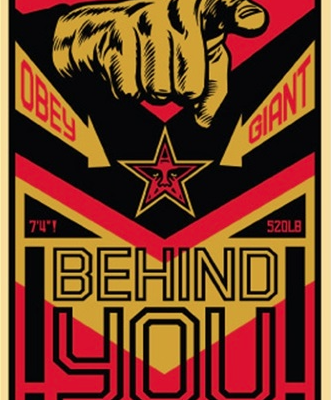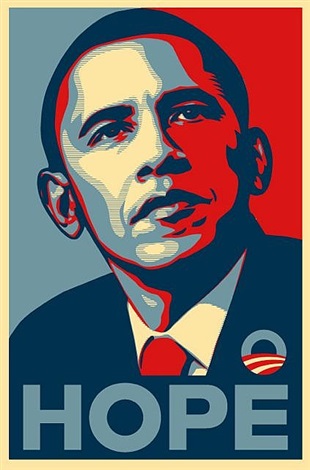Check out today’s article by artnet focusing on Shepard’s involvement in both street art, fine art, and his transgressive vision which enables navigation of both.
Here’s an excerpt from the story:
“Fairey’s use of powerful, accessible images and messages display an influence from early advertising, alt culture, and Pop artists like Andy Warhol. This combination of clear messaging and graphic compositions gives his work a broad appeal that speaks to a wide cross section of society.”
Is Shepard Fairey a Street Artist or Fine Artist?
Amah-Rose Abrams, Tuesday, November 17, 2015
Shepard Fairey, Obama Hope. Courtesy of Peach Editions.
Shepard Fairey’s background is rooted in American skate and punk rock culture, with his work born out of a combination of a graffiti aesthetic and a Pop art sensibilities. Straddling the divide between the fine art world and the street art world, Fairey—despite his massive popularity—has had to wait to be accepted by the more traditional art world. His higher profile has also, in turn, gotten him into some seriously hot water with law enforcement.
“To some people street art is vandalism, to others it’s gentrification, and either of those could be considered more legit than the other depending on your perspective,” Fairey said of this conflict in a recent interview with the Guardian.
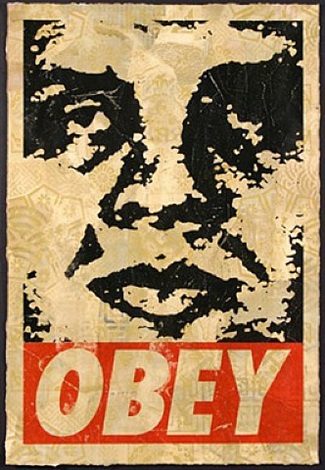
Shepard Fairey, Obey 95 (1995). Courtesy of Chester’s Blacksmith Shop.
Fairey was already well known for his OBEY Andre the Giant tags and stickers when he created the image Obama Hope in 2008, a block-colored portrait of the presidential hopeful Barack Obama. The image, now world-famous, was subsequently adopted as the official presidential campaign image.
Fairey’s use of powerful, accessible images and messages display an influence from early advertising, alt culture, and Pop artists like Andy Warhol. This combination of clear messaging and graphic compositions gives his work a broad appeal that speaks to a wide cross section of society.
“Street art has to stand out from the static, and contend with the metabolism of the city,” Fairey told the New York Times earlier this year.
His silhouetted “gig poster” aesthetic stands out in both the street and in a gallery setting. although, as opposed to Banksy, he is still viewed primarily as a street artist despite his indisputable commercial success.
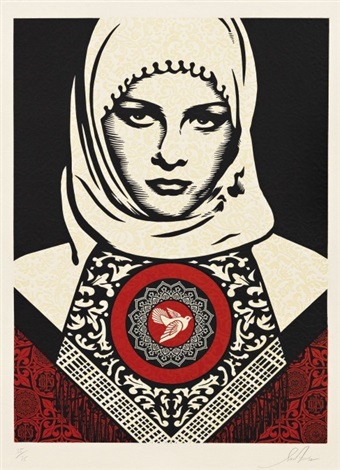
Shepard Fairey, Arab Woman Relief (2012). Courtesy of Gregg Shienbaum Fine Art.
“A lot of great things fall through the cracks in terms of art history or general history,” he said to the Guardian. “Other than that caveat, I really don’t care about the concept of legitimacy from anyone else’s perspective other than mine.”
Fairey’s work also has a strong political component. In addition to what is probably his most famous image, Obama Hope, he also created a poster in support of Ai Weiwei’s—now successful—campaign to regain his passport in 2014.
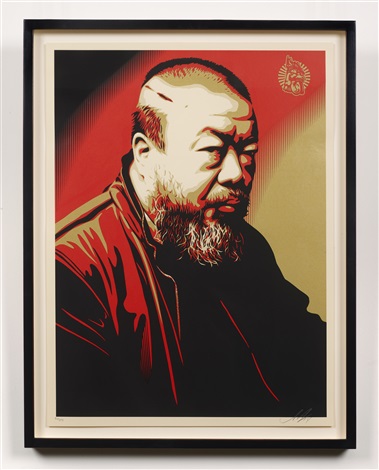
Shepard Fairey, Cost of Expression (Ai Weiwei) (2014). Courtesy of Delahunty.
Early in his career, during the OBEY sticker campaign that made him famous, Fairey seriously questioned the nature of his imagery. His work was more open to interpretation than it would be in a gallery context, being seen—as it was on the streets—alongside aggressive advertising. Rather than simply adding to the cacophony, he positioned his imagery as a wake-up call, intended to get people to question the advertising imagery that bombarded them every time they left the house.
Prior to his exhibition “Printed Matters” at the LSC Gallery in Detroit in mid-2015, Fairey proclaimed that he would be “tagging all over the city,” as well as creating his largest-ever mural, which now adorns the side of the Compuware building. This exhibition was followed by his first New York solo exhibition in five years, “On Our Hands” at his representing gallery, Jacob Lewis Gallery.

Shepard Fairey, Behind You Large Format (2009). Courtesy of Gregg Shienbaum Fine Art.
Unfortunately, Detroit authorities ultimately brought vandalism charges against the artist. Despite how much the public appreciates his graffiti work, he is now expected to stand trial in the city in early 2016, possibly leading to jail time. This certainly isn’t Fairey’s first legal dispute about his art—as the artist famously battled the Associated Press for what was or wasn’t “fair use” of the photograph he used to create the Obama Hope poster.
Fairey has firmly established himself as an outspoken counter-culture figure, often addressing issues of war, human rights, ecology, and politics. How he will maintain this—while continuing to create public works which could lead to prosecution on a regular basis—remains to be seen.
Fairey himself, however, seems unperturbed.
“Ten years ago I thought that hard work and moving up through the various stages of societal and cultural validation would make me feel secure and satisfied,” he told the Guardian. “Now, I would tell anyone that the most important thing is to be honest with yourself and be happy if you feel you’ve accomplished your vision—no matter what the rest of the world has to say.”
Members of the street art community and the fine art world will be watching as the trial unfolds, all the while his profile and accomplishments continue to grow. That being said, it is hard not to consider the wider implications of an artist of his stature doing jail time for simply undertaking their practice.
